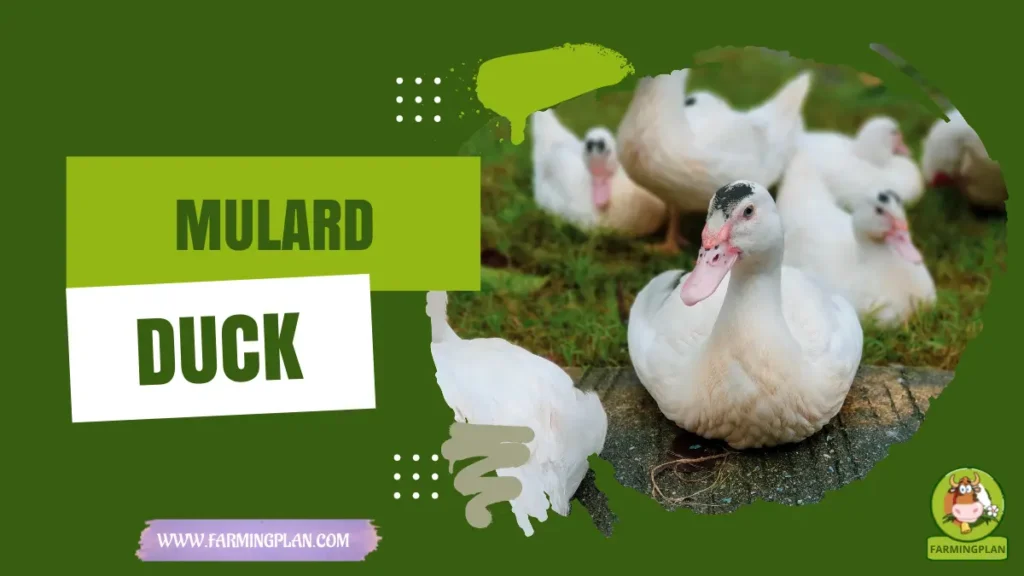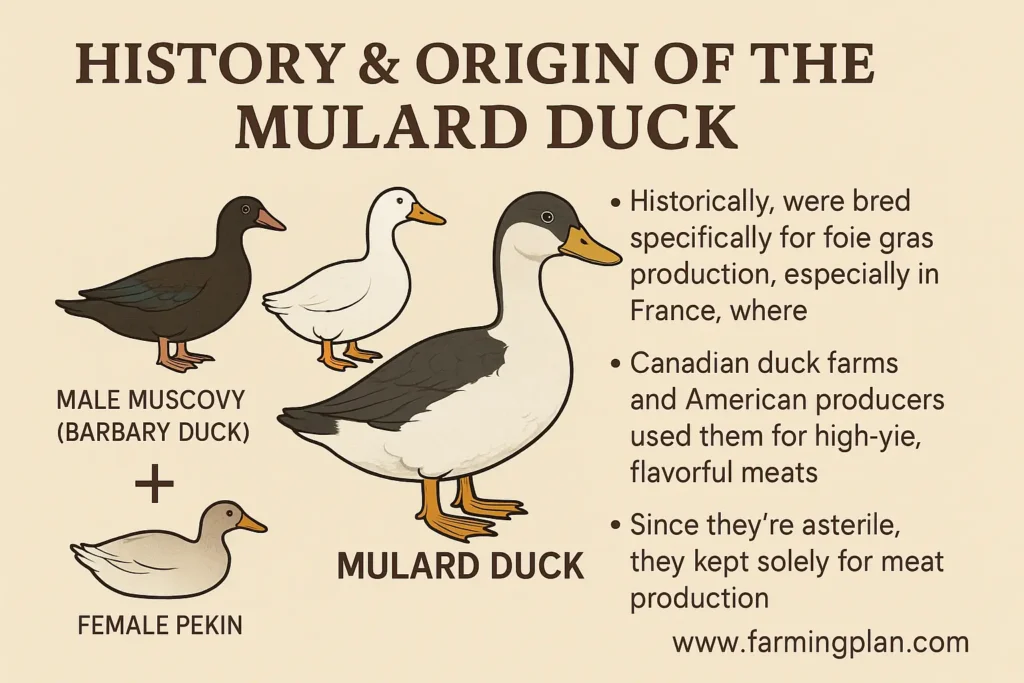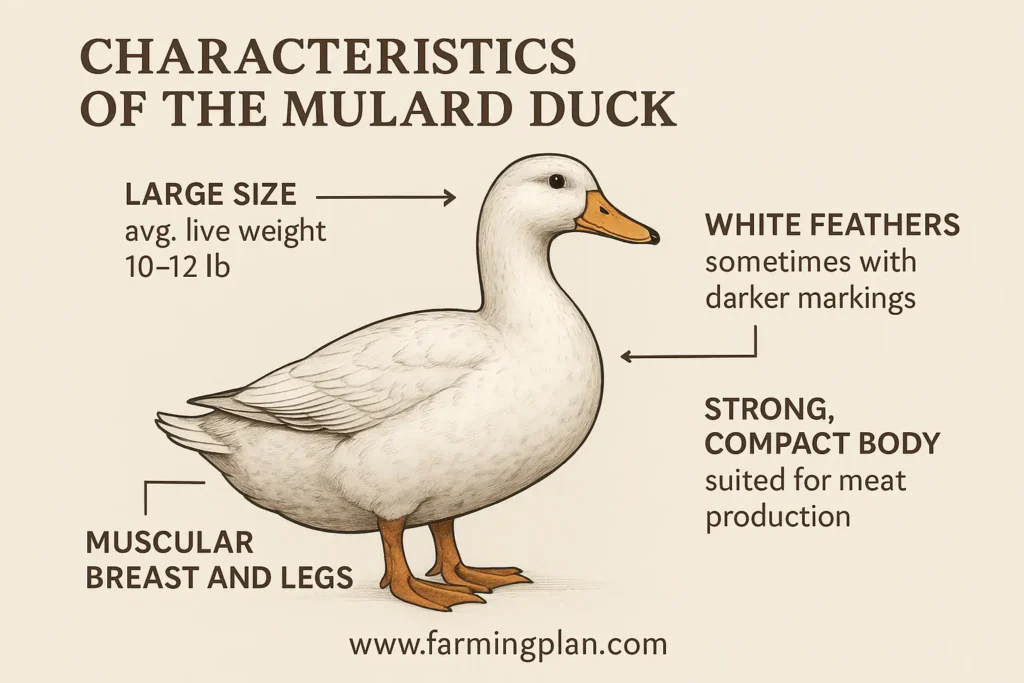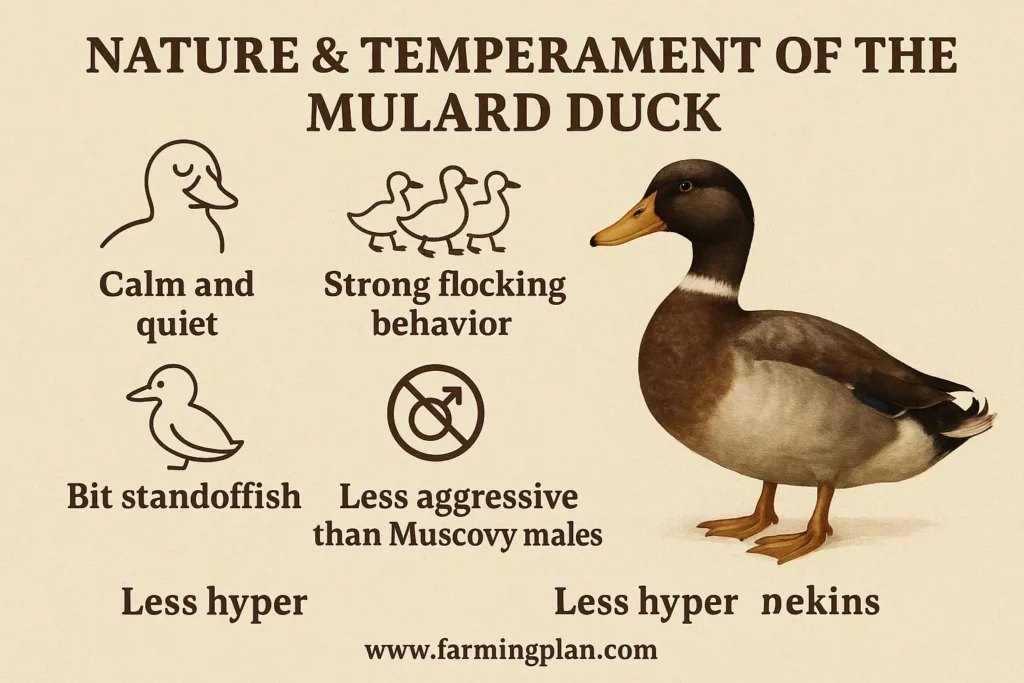If you’re anything like me, you’ve probably raised plenty of ducks and still get a thrill discovering a new breed that checks all the right boxes. Let me introduce you to the Mulard Duck a remarkable hybrid that’s completely changed the game on my farm and my dinner table. This breed is known for its bold flavor, large size, and surprisingly low-maintenance lifestyle. It’s not just a top choice for gourmet chefs or foie gras fans—it’s also ideal for farmers, breeders, and hobbyists who want high-quality meat without the fuss. In this article, I’ll share everything I’ve learned about raising Mulard Ducks from their origins to feeding habits and full care tips.

History & Origin of the Mulard Duck
The Mulard Duck also called the Moulard Duck or Mule Duck isn’t your average backyard bird. This duck is actually a hybrid, created by crossing a male Muscovy (also known as a Barbary Duck) with a female Pekin. That combo gives it the best of both worlds: the Muscovy’s lean build and rich meat, paired with the Pekin’s fast growth and calm nature.

Back in the day, these ducks were bred specifically for foie gras production, especially in France, where duck liver is practically a delicacy. Over time, Canadian duck farms and American producers caught on to just how useful these ducks could be not just for foie gras but also for high-yield, flavorful meats. Because they’re sterile, farmers keep them solely for meat production, which simplifies things. You don’t have to worry about separating males and females or surprise hatchlings messing up your flock plan.
Characteristics of the Mulard Duck
When you see a Mulard Duck for the first time, you’ll probably notice how big they are. I mean, we’re talking jumbo size here seriously, some of them look like they could bench press a Rouen. Their feathers are usually white, sometimes with darker markings depending on the parent stock.

As far as build goes, they’re muscular, especially around the breast and legs. That’s exactly what makes them ideal for dishes like duck leg confit and duck magret. The average live weight before slaughter hovers around 10 to 12 pounds, and the carcass yield is one of the highest among domestic ducks.
They don’t have the flashy plumage of a wild duck, but they do have a strong, compact body perfect for meat production. I’ve also noticed their appearance is cleaner almost like a duck in profile photo shoot kind of clean. That’s partly because they tend to keep themselves tidy, especially if they’ve got access to fresh water.
Nature & Temperament of the Mulard Duck
Now, if you’re wondering whether these ducks are friendly, here’s the scoop. Mulards are usually calm and quiet, which is great if you’re running a small farm or even a backyard setup. They flock together well, showing a strong natural flocking behavior, which helps if you free-range them like I do.

That said, they’re a bit standoffish. You won’t see them waddling over for belly rubs like some Pekins might. And since they’re sterile, they won’t be nesting or causing trouble with mating season antics.
In my experience, they do well in mixed flocks but shine best when kept in groups of their own. They’re less aggressive than Muscovy males and less hyper than Pekins—kind of like the Goldilocks of ducks: just right.
Read More: Cayuga Duck: An American Duck
Food & Diet Plan for Healthy Mulard Ducks
Let’s talk feed. If you want that clean, bold flavor Mulard meat is known for, you’ve got to feed them right. I stick with an all-vegetarian, grain-based diet mostly corn, wheat, and soy meal with some added greens and non-GMO options when I can.
Avoid feeds with animal by-products or artificial flavors. Trust me, it messes with the taste and isn’t worth the shortcut. These ducks grow fast, so they need a protein-rich starter feed for the first few weeks, then transition to a grower feed mixed with cracked corn or millet.
Make sure they always have access to clean, fresh water. They’re messy eaters, so check their water containers at least twice a day. You’d be surprised how quickly they turn it into soup. For pasture-based setups, I toss in some grass clippings and duck-safe veggies—it helps with flavor and saves on feed costs.
Common Usage & Purpose
The Mulard Duck is bred for one big reason: meat. This duck isn’t the kind you keep as a pet or enter into poultry shows. It’s made for the plate—and it delivers. Whether it’s roasted whole, turned into duck confit, or grilled as a duck breast fillet, this duck has flavor that chefs rave about.
In commercial farming, they’re also a top choice for foie gras production, especially in Europe. But even without the liver, the meat itself is a goldmine—rich, earthy, and far less greasy than other breeds. If you’ve ever worked with frozen or fresh duck products in catering or fine dining, chances are you’ve had Mulard.
I’ve even supplied some to a Full-Service Catering company that swears it’s their most requested poultry. The legs, in particular, are a favorite, with 3–4 per package being common for commercial distribution.
Read More: Call Duck: Fall in Love With the Friendly
Special Features That Make the Mulard Duck Stand Out
What makes this duck so special? For starters, its sterility. I know that sounds weird, but it means they put all their energy into growing meat instead of reproducing. That’s efficiency at its finest.
Second, the flavor. There’s nothing artificial about it—just earthy, bold, and clean. The muscle texture holds up beautifully in recipes that require slow cooking or crisping, like duck leg confit.
And lastly, let’s talk size. These ducks pack serious meat, especially around the legs and breast. You get a high meat-to-bone ratio, which makes every harvest feel worth it.
Read More: Aylesbury Duck: Raise England’s Finest White Duck
Health Issues & Prevention Tips
Like all ducks, Mulards are prone to a few health hiccups nothing major, but worth staying ahead of. The big one? Foot issues. If the ground’s too wet or rocky, you might see some limping or inflammation.
They’re also at risk for waterborne infections, especially if their ponds or drinkers aren’t cleaned regularly. I make it a point to change their water daily and scrub out containers once a week. Good drainage in their run is a must.
Vaccinations aren’t always necessary, but it doesn’t hurt to check with a local vet. Watch for signs like drooping wings, sluggish movement, or loss of appetite. Catching problems early saves a ton of stress—and ducks.
“Bold Flavor Meets Farm Simplicity The Mulard Duck Is A True Game-Changer For Meat Lovers And Backyard Farmers Alike.”
Step-by-Step Mulard Duck Farming Guide
Step 1: Build the Coop
Start with a dry, draft-free duck house. I use a simple wooden structure raised slightly off the ground with a sloped roof. Make sure it has good ventilation, especially in warmer climates. One square foot per duck is the bare minimum, but I go a bit bigger to keep them comfy.
Use straw or wood shavings for bedding, and change it weekly to avoid moisture build-up. Ducks love to poop, so this part isn’t optional if you want healthy feet and feathers.
Step 2: Prepare the Grazing Zone
I swear by free-range setups. Mulards thrive when they can forage on grass, insects, and leafy greens. If you don’t have pasture space, a large run with rotated patches works just as well.
Fencing should be around 3–4 feet high—nothing too fancy. They’re not great fliers, so you don’t need to clip wings.
Step 3: Install Water Containers
Access to water is non-negotiable. I place shallow rubber tubs throughout the run and refill them at least twice a day. They use the water to drink, clean their beaks, and help swallow food.
Don’t rely on natural ponds unless they’re clean and not shared with wild birds. Ducks love water, but it can turn into a bacteria pool fast.
Step 4: Feed Them Right
Start with a 20% protein feed for ducklings and gradually switch to a grower mix with whole grains around week 5. I mix my own sometimes corn, barley, oats, and greens. They eat a lot, especially as they near market weight.
No animal by-products, no artificial flavors that’s how you get the best meat quality. And always keep feed fresh. Moldy grain = sick ducks.
Step 5: Daily Routine
Mornings: Water change, feed check, flock count.
Afternoons: Let them graze, collect any feathers or droppings from the coop.
Evenings: Second feeding, secure them in the coop, quick health inspection.
It sounds like a lot, but once you get the rhythm, it’s just 20–30 minutes a day.
Step 6: Harvest Timing
Most Mulards hit market weight around 10–12 weeks. I weigh a few weekly starting at week 8. You’re aiming for that sweet spot of 10–12 pounds live weight with a good fat layer.
Butchering isn’t everyone’s thing, so line up a processor in advance if needed. The meat holds up great frozen and stores well for months.
Expert Tips & Best Practices
- Use organic feed if your market values it—price per duck goes way up.
- Raise in small flocks (10–20) for better health and less crowding.
- Rotate pastures weekly to prevent parasite build-up.
- Partner with local chefs to turn your ducks into high-end dining experiences.
- Avoid overfeeding—excess fat can ruin meat texture.
FAQ
What is a Mulard Duck?
It’s a sterile hybrid of a Muscovy drake and a Pekin duck, raised mainly for meat and foie gras.
Can Mulard Ducks reproduce?
Nope! They’re sterile by design, so all their energy goes into growing meat, not mating.
What do Mulard Ducks eat?
They thrive on a vegetarian diet—mostly grains like corn and wheat—with lots of greens and fresh water.
How big do Mulard Ducks get?
They typically reach 10–12 lbs before processing, making them one of the biggest domestic duck breeds.
Is the meat from Mulard Ducks good?
Absolutely—it’s rich, clean-tasting, and perfect for gourmet dishes like duck confit and grilled duck breast.
Conclusion
The Mulard Duck has become one of my absolute favorites on the farm. Between its meaty build, clean diet, and flavorful results, it offers everything I want in a meat duck. It’s easy to raise, simple to feed, and a joy to harvest. Whether you’re catering to fine-dining chefs or stocking your own freezer, this hybrid breed delivers time and again. With the right setup and a bit of daily care, Mulard Ducks can easily become the most rewarding part of your poultry operation.

